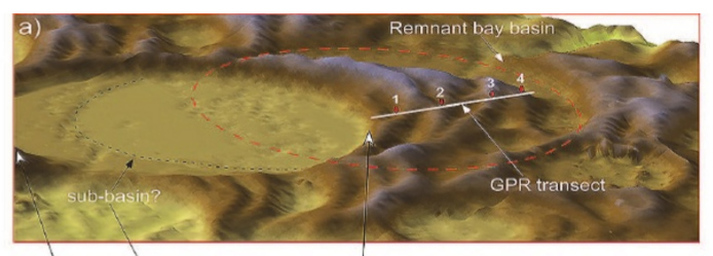
|
The post about the Carolina Bays that I wrote a couple of weeks ago turned out to be relatively popular (as far as this webpage goes, anyway). Carolina bays are elliptical depressions of varying size that occur along the Atlantic Coastal Plain in a band extending from New Jersey to Florida. Their limited geographic distribution and northwest-southeast orientation has given rise to many ideas about how these features were formed. Ongoing debate centers around the question of whether the bays formed as (1) the result of impacts associated with an extraterrestrial object (e.g., debris ejected by a comet strike in Saginaw Bay) or (2) through the actions of wind and water during the Pleistocene. Extraterrestrial or terrestrial? A new paper by Chris Moore and colleagues (see full reference below) in Southeastern Geology provides more evidence that the bays were formed and modified over long periods of time by natural, terrestrial processes. You can read the paper for yourself here. The analysis in the paper focuses on Herndon Bay, a 1-km long elliptical depression in Robeson County, North Carolina. Using a combination of detailed surface mapping, ground penetrating radar data, geomorphological analysis, and age estimates obtained using OSL, Moore et al. show that punctuated migration of Herndon Bay to the northwest from about 41 to 24 thousand years ago produced a sequence of sand rims on the southeast side of the basin. The bay held its shape and orientation as it migrated over the course of thousands of years.  A portion of Figure 3 from "The Quaternary Evolution of Herndon Bay, a Carolina Bay on the Coastal Plain of North Carolina (USA): Implications for Paleoclimate and Oriented Lake Genesis." The numbers show locations of dated sand rims left by migration of the bay (4 is the oldest, 1 is the youngest). The evidence and analysis that Moore et al. present is a pretty strong argument against the idea that the bays were formed by a single event (i.e., an extraterrestrial impact). I encourage you to take a look at the paper. I'll just paste in a paragraph from their conclusion (pg. 168): "The characteristics of Carolina bays, including basin shape, changes in basin orientation with latitude, and sand rims reflect long-term and pervasive environmental, climatological, and hydrological factors over millennia rather than from sudden or catastrophic events (Kaczorowski, 1977; Thom, 1977; Carver andBrook, 1989; Brooks and others, 1996; Grant and others, 1998; Brooks and others, 2001;Ivester and others, 2007, 2009; Brooks and others, 2010). The fact that practically all Carolina bays in a particular geographic region have nearly identical patterns of shape, orientation,and sand rim composition suggests similar processes working over long periods of time. This study also indicates that Carolina bays can respond rapidly, and appear to become more active during periods of climatic instability. While many nuances of bay evolution remain to be re-fined, the evidence at Herndon Bay clearly supports the concept that Carolina bays represent a regional example of a globally-occurring phenomenon: They are wind-oriented lakes shaped primarily by lacustrine processes." Reference: Moore, Christopher M., Mark J. Brooks, David J. Mallinson, Peter R. Parham, Andrew H. Ivester, and James K. Feathers. 2016. The Quaternary Evolution of Herndon Bay, a Carolina Bay on the Coastal Plain of North Carolina (USA): Implications for Paleoclimate and Oriented Lake Genesis. Southeastern Geology 51(4): 145-171. Addendum (3/18/2016): Let's start over with the comments. Please keep comments on the topic of the blog post (Carolina bays) or I'll delete them.
3/18/2016 08:51:57 am
The extraterrestrial hypothesis has been in death throes for a while. You noted in your last post that it has little support; there is NO evidence that current supports the comet or asteroid idea. But it is SO interesting that it won't die. Typical.
SteveGinGTO
3/19/2016 05:05:37 am
Actually, Sharon Hill, ALL of the hypotheses for the formation of the Carolina bays have failed at every turn - and that includes aeolian. Douglas Johnson thoroughly vetted them all half a century ago, and every generation of aeolian scientists keeps resurrecting it and not adding one iota of good evidence. 3/25/2018 05:43:59 pm
Several points that clear up many of the question above: 3/25/2018 07:24:45 pm
tensile fracture, an enormously energetic and extremely high-speed form of failure, which according to Rager et al (2014) would propagate through the bulk volume at rarefaction speed, much faster than the time scale of subsequent auto-excavation following initial bulk fracturing. Is this what happened to the “missing overburden” of the Michigan Basin? 3/25/2018 08:10:27 pm
explain how variable impedance to volatile outflow with entrained aggregate (comminuted target mass) becomes imprinted as variable flux patterns of the aggregate within the outflow. Hypersonic bow shock leaves a lower flux of entrained aggregate in the wake of a larger obstruction within the flow (ballistic coefficient of obstruction >> that of entrained aggregate particles) and an increased flux of entrained aggregate in a cone around that wake. That flux pattern is then convoluted by suborbital mechanics during exoatmospheric transport, to eventually become emplaced as the Carolina bays sand blanket having shallow oval depressions with shallow elevated rims or partial rims, or sometimes just no rims at all. Rims or not, the regional Davias Archetype planform is always adhered to regardless of the physical scale of a given expressed bay depression. 3/25/2018 08:12:55 pm
The counterpart e-poster to the abstract (https://agu.confex.com/agu/fm17/mediafile/Handout/Paper236973/AGU 2017 Davias Harris P11A-2499 ePoster.pdf) illuminates many remarkable details regarding the vast sand blanket and ovoid depressions imprinted within. The size of peak occurrence is essentially independent of emplacement elevation above sea level, another signature of “suborbital delivery” or non-terrestrial transport process. 3/25/2018 08:14:46 pm
The impedance of this overall mass transport scheme is born within the Carolina bay imprint, in many different ways. 4/8/2018 09:26:17 pm
Hi Mr. (Professor) Harris:
SteveGinGTO
3/19/2016 04:57:05 am
WTF? That article is about the work of Christopher Moore and it looks like a rehash of the same STUFF that he pandered 2 years ago.
Shane Miller
3/19/2016 08:49:50 am
Never thought I'd see someone troll this hard on a post about Carolina Bays. Sheesh...
SteveGinGTO
3/19/2016 10:27:13 am
It's not trolling to have a different opinion. NONE of the explanations that have been tried work - and you know that. And you only accept comments supportive your failed and failing explanation.
E.P. Grondine
3/23/2016 07:56:01 pm
Steve (Garcia) -
Steve Garcia
4/2/2016 02:11:42 am
Ed -
Steve Garcia
4/2/2016 02:13:57 am
Ed -
Shane Miller
3/19/2016 12:31:20 pm
Well, my opinion is that Chris Moore is one of the brightest and most methodical geoarchaeologists in eastern North America, and his publication record speaks for itself. He does a great job of following where the data takes him.
Bill Wagner
3/31/2016 07:59:34 am
Entertaining reading here in the peanut gallery.
Andy White
3/31/2016 11:42:47 am
There's just the inconvenient problems that the Carolina Bays date to many different times (suggesting a common process over time rather than a single event) and were in existence prior to the Paleoindian period.
Steve Garcia
4/2/2016 02:19:25 am
Actually, the differnt dates is because no one has figured out where to properly take samples for C14 or OSL. The bays are secondary impacts from Michael Davias' Saginaw Bay impact site, which, though about 1,000 km away is mathematically tied to the 45,000 bays - ALL of them. Aeolian can't explain that, because aeolian is a local phenomenon. 2/1/2018 05:18:44 am
The temporal aspects of the Carolina bays are confounded by the historical lack of adequate dating technologies. The sediments in the bays were sampled as long ago as the 1930s using pollen, and it showed the passing of at least one glacial cycle, and perhaps several. When Carbon dating became available, deep bay samples were listed as ">50ka", not because they were 50k old, but they were older than that. 50ka is the limit of that isotope's abilities. Then we received the OSL technology, so well adapted and applied to Moore's and Iverster's archeological work. When they got down deep, they started reporting >120ka, because that is where that technology peters out. My hypothesis suggest they are far older still, and now we can bring to the table the beryllium/aluminum isotopic burial dating, that reaches back 5 million years. If there is any merit to the hypothesis, we will see burial dates for the sediments beneath the rim sands to have been buried 800ka. Be10/AL26 dating has already found the existence of a mid-plicotocene "regolith injection" in glacial tills and cave sediment deposits. We must be carful to distinguish between true bay rim formations and the surficial layers of eolian and fluvial sediments blanketed over the rims in the intervening 800,000 years.
J. Hoekendijk
4/11/2016 04:31:23 pm
Electrical scarring? All mechanical erosion models fail since bays formed to the same depth independent of formation. That is ... hard and soft formations have same depth rather than differing depths. Thus ... mechanical processes seems very unlikely. That leaves 'other than mechanical' sources. How ... I don't know. The consistent orientation and differing bay ages suggest, to me, of a periodic extraterrestrial encounter with object(s) and electrical interaction.
Andy White
4/11/2016 05:19:37 pm
Where are you getting that they're all the same depth? Everything I've looked at suggests they vary from seasonal marshes to open water.
Steve Garcia
4/11/2016 06:05:07 pm
Andy, thanks for catching that. I've never heard the same depth thing. I doubt anybody has ever measured them, and re-working would have made them unequal over time, even if they started that way. Which I don't think is true, either.
Steve Garcia
12/30/2016 11:20:46 pm
Andy - Actually, Micheal Davias (cintos.org) is the guy who has done LIAR on all the 45,000 CBs, and the LIDAR itself should be able to show the depths of the CBs. Like the dating samples, I imagine peoplw will be measuring from all sorts of different places on the rims, allowing them to claim all sorts of things about equal depths or unequal depths, whichever suits their preferred interpretations. 2/1/2018 05:29:03 am
There is a slide show on my website that displays over 400 maps of LiDAR-measured elevation transects crossing bays. Of course, this only shows the bay floor to rim relief, and currently hydraulically closed bays are know to have deep sediment fill. Most relief is under 3 meters, but I've seen 10 m from basement of rim to surficial rim. Try MPTimpact dot org /CB/EPmaps/, and give it some time to set up.
Steve Garcia
4/11/2016 06:03:38 pm
Nope, not an EU guy. Sorry to disappoint.
Andy White
4/11/2016 04:48:45 pm
So nobody knows how to date sediments (because the bays date to many different times). . . and the multiple concentric rims are just an inconvenient anomaly . . .
Steve Garcia
4/11/2016 07:04:31 pm
Sampling in a uniformly stratified region would make C14 and OSL easy. Somehow that hasn't happened. You can put it as different ages. That would be one suggestion. Or if the sols were turbulated, who knows WHAT one would get for dates.
Steve Garcia
4/11/2016 07:31:59 pm
"What is the positive evidence for an extraterrestrial impact origin other than "they look kinda like craters"?"
LeeA
5/16/2016 12:14:25 pm
The orientation of Carolina bays and that of the lake basins in Nebraska/Kansas all have a shifting orientation that suggests that they are not primary impact sites but could in fact be secondary impact sites due to the ejecta of a hyper velocity bolide impacting somewhere north of Michigan. The secondary bolides coming from the ejecta would have been of various sizes and mass. As such they would be able to provide multiple impacts which would vary in size and exact distance from primary point of impact. In addition, multiple secondary bolides could strike in close proximity, generating overlapping craters. Should this coordinate with the Clovis comet impact theory, these bolides would have been fragments of the Laurentide Ice Sheet and been mostly ice with some containing erratics taken up by the glaciers. This is all nicely summarized on this web page: http://www.scientificpsychic.com/pubs/carolina-bays-presentation/carolina-bays-presentation.html
Andy White
5/26/2016 03:22:01 pm
If a single Clovis site is located on the rim of one of the bays, the bays were not the result of an impact during the Younger Dryas.
Steve Garcia
5/26/2016 06:13:56 pm
Andy, you seem to be making some assumptions there.
Andy White
5/27/2016 06:05:47 am
Hi Steve, 1/27/2018 07:49:40 pm
There are significant problems with Saginaw Bay, Michigan, being both an impact crater and source of ice impactors involved in the formation of the Carolina Bays. First, Saginaw Bay was partially ice-free starting about 16,000 BP and completely ice-free by 14,000 BP. Thus, there was not the thick ice sheet that could either be a source of bay-forming ice secondary impactors or cushion the underlying bedrock from an impact at the start of the Younger Dryas. Second, proglacial lake deposits, shoreline, and deltas as old as 16,000 BP ring all or parts of Saginaw Bay and unddisturbed deposits of the same age underlie it. Thus, Saginaw Bay is definitely too old to have been formed by a hypothetical Younger Dryas Impact. Maps of bedrock topography that have been created from abundant water and oil well holes show a complete lack of the kilometers-deep hole and associated bedrock deformation that such an impact would have created. The data can only be interpreted to conclude that the Saginaw Bay crater is a completely imaginary entity and, as a result, cannot be used to explain the Carolina Bays. 1/30/2018 06:56:34 am
Bill Brikelad has done a superb job of decimating the YDB impact's involvement with the Carolina bays. Although the Saginaw Bay hypothesis used that timeline 10 years ago, it has migrated back in time with the data - thought the Illinoian and into the Mid-Pleistocene. 3/25/2018 09:19:09 pm
Terrestrial ice is typically nowhere near strong enough to survive as any large piece when impulsively boosted to the 3.5 or 4 km/s required to reach emplaced regions of Carolina bays. Ice has essentially no constitutive strength and cannot remain as a coherent structure when loads are applied to large pieces. At that level of impulse, the ice would be turned to crunched up low pressure ice and water, which would not likely survive in any coherent stream above the atmosphere for the required 800 to 1200 km range.
Charles Viau
12/30/2016 10:20:08 pm
The original presentation of the Bloody Creek crater in Nova Scotia looked exactly like a "Carolina Bay", before it was filled in by breaching a river and making a reservoir out of it. The original structure was found by a pilot in a set of early arial photographs. Shocked quartz and carbon spherules were found, as well as increased levels of iridium. It should be studied further. Dates so far put it at the Younger Dryas event.
Steve Garcia
12/30/2016 11:24:28 pm
Charles - Any sources we can follow up on, in terms of what you are saying? It all sounds plausible, but 4 lines of comment aren't much to go on. 1/27/2018 07:03:04 pm
Steve wrote:
Lon Hudson
12/12/2018 09:50:45 pm
Initially, no one believed that the crater in Arizona was in fact a meteor crater. When I was in Jr High school, no one believed that the continents moved around the surface. By the time I got to college, it was accepted fact. All we have are "snap shots" of our past. Yet, we talk as if they can be tied together as a coherent full length film. My Chemistry professor said that science was based on skepticism and an open mind and curiosity. 5/31/2019 05:18:04 pm
Nice to see this topic still elicits thoughtful remarks such as Leon's. My experience suggests that established scientists approach with a good sense of skepticism, but view curiosity as that which killed the cat... and run away. 10/6/2019 07:51:25 pm
Check GSA 2019 Phoenix author listing for Davias & Harris on this topic. 3/29/2022 03:22:42 pm
Check our joint GSA Books chapter 24 in volume 553 "In the footsteps of Warren B. Hamilton..." behind a $10 paywall fee at: 3/29/2022 03:33:19 pm
Also see these two 2022 GSA Northeast Section meeting talks from Lancaster PA: 3/29/2022 03:42:24 pm
Also here are some results from the suborbital analysis shareware (GSA Books volume 553 "In the footsteps of Warren B. Hamilton..." chapter 23) applied to the North American tektites per two posters from the 53rd Lunar and Planetary Science Conference (2022): Comments are closed.
|
All views expressed in my blog posts are my own. The views of those that comment are their own. That's how it works.
I reserve the right to take down comments that I deem to be defamatory or harassing. Andy White
Email me: [email protected] Sick of the woo? Want to help keep honest and open dialogue about pseudo-archaeology on the internet? Please consider contributing to Woo War Two.
Follow updates on posts related to giants on the Modern Mythology of Giants page on Facebook.
Archives
January 2024
Categories
All
|


 RSS Feed
RSS Feed
